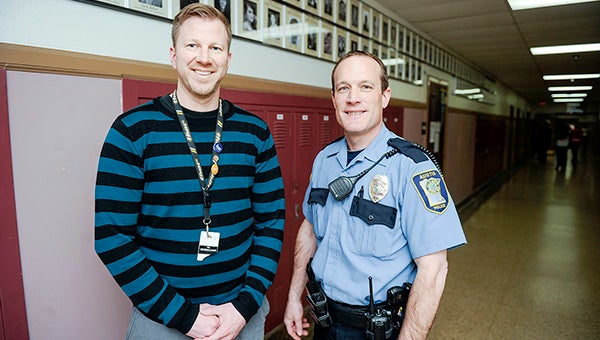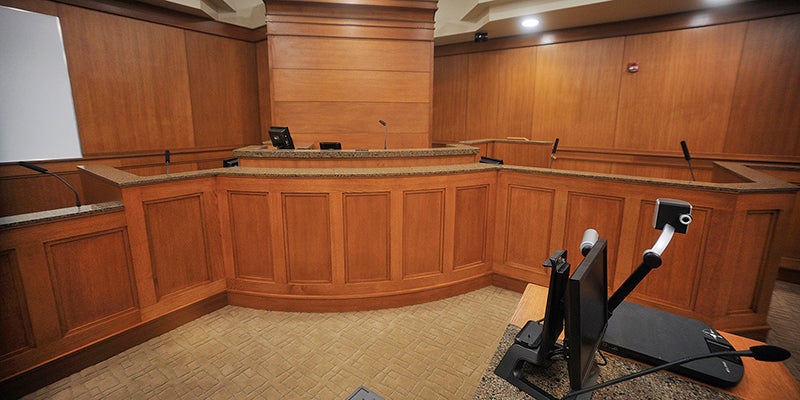Schools, health officials think council’s e-cigarette ban sends the right message
Published 6:01 pm Sunday, March 22, 2015

Austin Public Schools REACH Program Coordinator Thor Bergland and lAHS School Resource Officer James Lundt see first-hand the use of e-cigarettes in the schools. Eric Johnson/photodesk@austindailyherald.com
Shifting views?
Smoking on school grounds isn’t a new problem. But as students move from pens and paper to laptops, their cigarettes are also getting upgrades.
While traditional tobacco use has dropped in schools, electronic cigarette use has increased. The devices, which heat a nicotine solution to create a vapor instead of burning tobacco, are becoming popular among students.
According to an annual government survey of more than 41,000 students, e-cigarettes have surpassed traditional smoking in popularity among teens; however, AHS student surveys and other state surveys don’t yet address e-cigarettes.
Austin’s no different. Austin Public Schools REACH Program Coordinator Thor Bergland said he’s seen the trend in e-cigarettes — also called vaporizers or vapes — rise this school year.
“It is a trend that has increased in its behavior and social acceptance,” said Bergland, the former Chemical Health Counselor for Austin High School.
Setting a standard
Last Monday, the Austin City Council voted 4-3 to approve a ban on e-cigarettes in public places like bars and restaurants, going above and beyond what’s already banned under the state’s Clean Indoor Air Act.
Some had argued that e-cigarette use at the school shouldn’t factor into the city ban, but Bergland said it’s important for the students to not view e-cigarettes as an acceptable alternative.
“You really make your barriers by setting these precedents, these ordinances,” Bergland said. “You want to stay ahead, not behind.”
Bergland hopes the council’s vote to approve the e-cigarette ban will help show that the devices could be just as harmful as regular cigarettes and they are not accepted as a healthier alternative in the community.
“We as a community should have a voice and stand loud and proud and protect all of us,” he said. “Not just kids but adults as well.”
E-cigarettes are often marketed as tools to help people stop smoking and as a healthier alternative to regular cigarettes. That means students don’t always think the devices are as harmful as traditional tobacco, which people like AHS School Resource Officer James Lunt say is not the case.
“That is the sad part, almost all students that I deal with see nothing wrong whatsoever with having an e-cigarette in the school,” Lunt said. “They know it’s nicotine but they just don’t think it’s harmful in their surroundings.”
Mower County Statewide Health Improvement Coordinator Karissa Studier said there hasn’t been much research released on e-cigarettes, but that’s starting to change.
In January, California — a leading state in tobacco research and prevention — released the “State Health Officer’s Report on E-Cigarettes: A Community Health Threat,” a report labeling e-cigarettes as a community health threat.
The report showed at least 10 chemicals contained in the devices are known to cause cancer, birth defects and other reproductive harm.
“That’s a pretty big statement, I believe,” Studier said.
That report also found e-cigarette users are no more likely to quit than traditional smokers, that e-cigarette advertisements have been able to circumvent restrictions on traditional tobacco, and that companies are using old-school tactics to appeal to children and imply the products are safe.
Bergland agreed the devices are being marketed to a younger generation that perceives them as low-risk.
“Those companies have a marketing scheme for younger people with all the flavors that they’ve promoted and produced and marketed,” Bergland said. “So the kids will talk about the different fruit flavors.”
The California report suggests e-cigarette branding and lax marketing restrictions may undermine progress and educational efforts on traditional tobacco.
“These data suggest a new generation of young people will become addicted to nicotine,” the report reads.
“I think that’s a big issue right now that there’s not a substantial amount of research done yet,” she said.
Studier admitted the community’s views on e-cigarettes are mixed, but she hopes the city’s ban will send “the message to youth that electronic cigarettes aren’t maybe as safe as they seem on TV or they might think.”
Detection
Though more studies are being released, e-cigarettes still present problems for schools. For starters, they are almost undetectable and don’t carry the distinct aroma of traditional tobacco products. Since they’re hard to trace, Bergland said only a few students have been caught with the devices.
“The problem is that they’re hard to detect because they’re odorless; they can be concealed easily,” Bergland said. “[Students] also think that there’s no dangers with them.”
Lunt has cited about 10 to 12 students so far this school year for having e-cigarettes, which he said is more than the previous year he worked with the school.
“There’s been a steady increase with the electronic cigarette citations that I’ve been writing,” Lunt said.
But ways to catch students with the devices are limited to seeing a student use them or being alerted by teachers or other students.
“My problem in the school is locating them,” he said. “ … [students] can hide them in so many different places. They could just be in a pocket and you wouldn’t know it.”
Lunt receives reports almost every week from someone who walked into a bathroom and saw a student taking hits off an e-cigarette. It is against state statute and AHS rules for anyone to have tobacco on school grounds, and Lunt said consequences vary on a case-by-case basis. One student was fined $120 based on state laws, he said.
Superintendent David Krenz said school punishments also vary.
“It all varies depending on our discipline policy, but anywhere from a reprimand from a suspension to getting the police involved because it is illegal,” he said. “And when it’s a student or an adult they can’t smoke on school property, so that’s pretty well spelled out in state statute, and e-cigarettes would fall into that category.”
Krenz said the district teaches students about tobacco and drug use in health classes.
“All of our health classes starting at an early age deal with drug and substance abuse and that sort of thing,” he said. “So it’s part of our regular health and wellness curriculum. And I would assume with the onset of e-cigarettes hopefully that will be addressed too.”
Austin and schools across the county are also clamping down because e-cigarettes can also be used for illegal substances like marijuana.
“What we’re concerned with, with vaporizers, is that people are capable of putting drugs in them,” Lunt said. “For instance marijuana or THC.”
Lunt made clear officials have not found narcotics or drugs in e-cigarettes at Austin High School yet, but it’s a significant concern with the devices.
However, Austin Police Captain David McKichan said it’s happening locally.
“We have seen it locally and we know that one of the trends nationally is you can use substances other than tobacco with it,” McKichan said.
Nationwide, some schools are starting to treat e-cigarettes even more harshly than normal cigarettes because of the possibility of drug use.
The National Association of State Boards of Education doesn’t have an official policy on e-cigarettes, but Executive Director Kristen Amundson said she believes the group would recommend that the devices be treated as tobacco products. But if a school district thinks they have a particular problem with the devices, then sending a really clear message may be a good idea, she said.
—The Associated Press contributed to this report.




